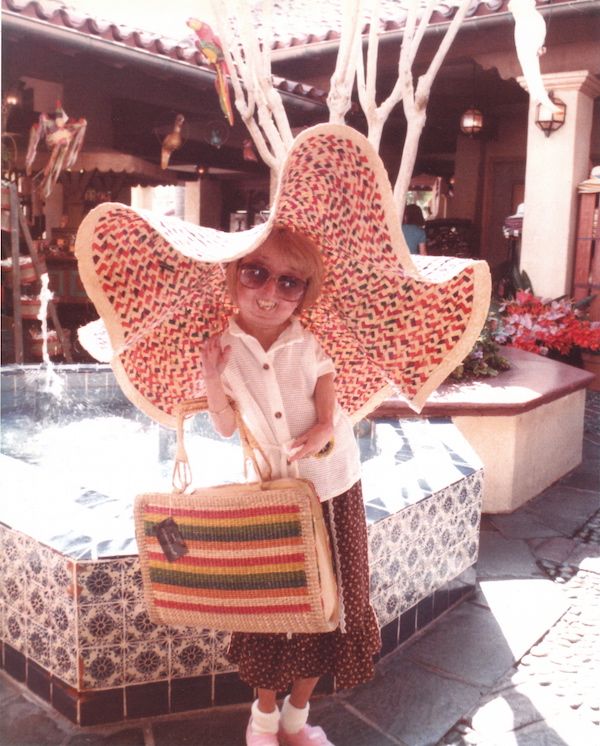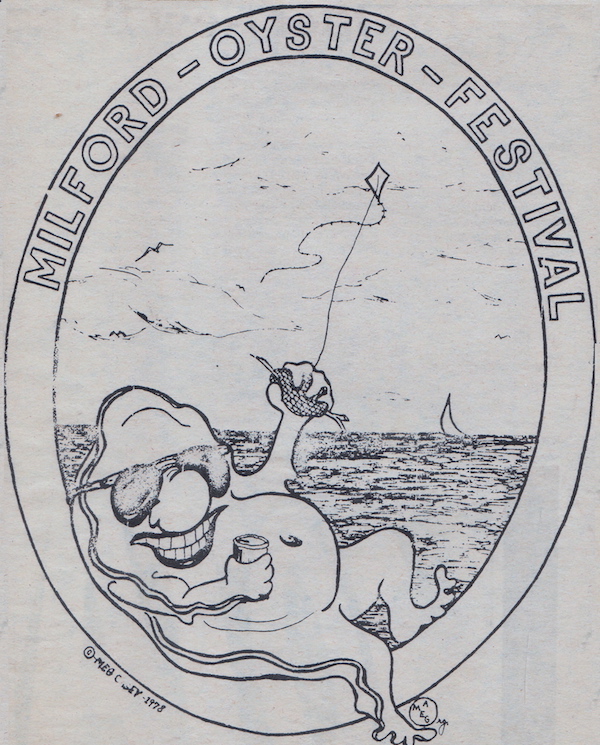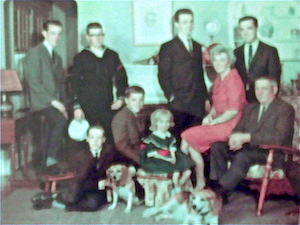



Milford Oyster Festival logo
by Meg Casey
Wearing a long blonde wig and a smile, Meg Casey maintained an independent life with a feisty sense of humor that many remember fondly. The first 10 years of the Milford Oyster Festival, from 1975 until 1984 plus a compilation design in 1985, had t-shirts designed by Meg Casey, the oldest person to die on May 26, 1985 at age 29 and 238 days, from the disease progeria where the body ages rapidly. Doctors were initially puzzled about young Meg but her dentist correctly recognized her condition. Meg born October 1 1955 grew only to an adult height of less than 4 feet , living to double of the expected life expectancy of 13. As one of the few adults with progeria she took on the challenge of becoming a role model and a vocal handicapped advocate, often using her sharp tongue to get a point across if the need arose.
Meg pushed for handicapped patients to be treated as people with dignity. Despite her objections to being viewed as an oddity during her short life, 30 years later some supernatural believers have speculated in online forums that extra-terrestrials look like Meg. She resented being considered as a lab specimen to be paraded by doctors in front of the hospital interns for observation. One of these former Yale med students used DNA testing, which was not available during her lifetime, on a tissue sample he had collected 20 years earlier from Meg. Without considering notifying the Casey family, he held a press conference in 2005 announcing that Meg may not have had progeria but a similar aging disease with the unflattering acronym of M.A.D. for the hard to remember name of Mandibuloacral Dysplasia Type A. It is common for rare diseases to be misdiagnosed due to few specialists familiar with them and the limitations of the detection methods available at the time. Meg may have subtly poked fun at the doctors when she used that same acronym for her handicapped issues column "M.A.D. (Most Able Disabled)".
No matter what afflicted her, Meg regarded her condition as an inconvenience, not defining who she was. Meg would adapt by doing things differently such as drinking from a wine glass because it was easier to hold in her toddler sized hand. Her efforts along with changing attitudes happening elsewhere in the early 1980s led Milford and other communities to start becoming accessible to all. Upon moving out when she became an adult, intensely independent Meg's house house was rebuilt with lower windows and the kitchen counters set at a height for her to reach everything. A roommate helped with some tasks she had difficulty with and help with the shopping because she didn't have a vehicle outfitted with special controls for Meg to drive.
Meg's handicapped issues column for the local Milford Citizen newspaper covered a wide range of topics from fitting in to facing death. One reader asked Meg about going dancing, 30 years before "Dancing With The Stars" included people with disabilities or others not normally considered as the type to be the belle of the ball in order to achieve higher ratings. Meg traveled to meet and encourage younger progeria patients that were not expected make it to their teens. On a moment's notice she flew to Disneyland to speak up for some progeria pre-teens after seeing on the news how the press negatively treated them as oddities while on their trip by the Sunshine Foundation. This led to an appearance on the Phil Donahue Show.

Meg Casey's family
photo courtesy of the Casey family
This sense of inclusiveness was learned early on from her family treating her equally like the rest of her brothers by encouraging her to participate in activities. Meg attended one of her brother's birthdays the weekend she passed. She was so loved by those that knew her that instead of being hidden off to the side, her family and grammar school class photos featured Meg front and center. Often photographers tended to try to emphasize how she looked different from everybody else. One photograph was titled "Growing Up Old". Meg was a pioneer of the idea of mainstreaming people facing challenges. Many people with disabilities lead normal productive lives including indoor and outdoor activities, sports and work.
With fragile bones making walking difficult and physically resembling a child with elderly features, Meg sought to be like any normal person including a wish for a boyfriend. Milford's Meg Casey won praise from President Ronald Reagan after he read "The Courage of Meg Casey" in Reader's Digest. The excerpt of this Pulitzer Prize nominated article by Nancy M. Tracy originally appeared in the Hartford Courant. The January 1984 issue of Reader's Digest also included an article about the Special Olympics.